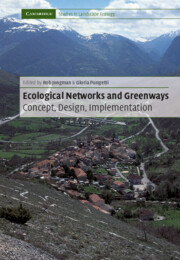Book contents
- Frontmatter
- Contents
- List of contributors
- Foreword
- Preface
- Acknowledgements
- 1 Introduction: ecological networks and greenways
- 2 The context and concept of ecological networks
- 3 Greenways in the USA: theory, trends and prospects
- 4 Ecological functioning of ecological networks: a species perspective
- 5 Impacts of roads on ecological networks and integration of conservation and transportation planning: Florida as a case study
- 6 Ecological corridors on a European scale: a typology and identification of target species
- 7 Planning the future landscape between nature and culture
- 8 From models to reality: design and implementation process
- 9 Design of the Pan-European Ecological Network: a national level attempt
- 10 Ecological ‘black spots’ within the ecological network: an improved design for rural road network amelioration
- 11 An ecological network for the Milan region based on focal species
- 12 Connecting corridors: implementing metropolitan greenway networks in North America
- 13 The Florida Statewide Greenways Project: its realisation and political context
- 14 The ecological network development in the Yungas, Argentina: planning, economic and social aspects
- 15 The river corridor of the Guadiamar
- 16 Conclusions: into the twenty-first century
- References
- Index
4 - Ecological functioning of ecological networks: a species perspective
Published online by Cambridge University Press: 29 December 2009
- Frontmatter
- Contents
- List of contributors
- Foreword
- Preface
- Acknowledgements
- 1 Introduction: ecological networks and greenways
- 2 The context and concept of ecological networks
- 3 Greenways in the USA: theory, trends and prospects
- 4 Ecological functioning of ecological networks: a species perspective
- 5 Impacts of roads on ecological networks and integration of conservation and transportation planning: Florida as a case study
- 6 Ecological corridors on a European scale: a typology and identification of target species
- 7 Planning the future landscape between nature and culture
- 8 From models to reality: design and implementation process
- 9 Design of the Pan-European Ecological Network: a national level attempt
- 10 Ecological ‘black spots’ within the ecological network: an improved design for rural road network amelioration
- 11 An ecological network for the Milan region based on focal species
- 12 Connecting corridors: implementing metropolitan greenway networks in North America
- 13 The Florida Statewide Greenways Project: its realisation and political context
- 14 The ecological network development in the Yungas, Argentina: planning, economic and social aspects
- 15 The river corridor of the Guadiamar
- 16 Conclusions: into the twenty-first century
- References
- Index
Summary
Introduction
One of the main functions of ecological networks is to protect and enhance biodiversity. If we want to know whether conservation and restoration plans meet our biodiversity goals, we should be able to assess them. Over the years, research on the functioning of ecological networks and investments in assessment tools have made it possible to do this. In this chapter we combine the Landscape Cohesion (LC) approach developed by Opdam et al. (2003) with Ecologically Scaled Landscape Indices (ESLIs) (Vos et al. 2001) and spatial sustainability standards (Verboom et al. 2001). The approach is based on the functions of an ecological network for the organisms that inhabit it. In this approach, ESLIs are compared to standards resulting in a rating of the landscape. This rating can be viewed as an index of landscape ecological spatial quality (Figure 4.1). A complication when assessing biodiversity is that every species perceives a landscape from its own perspective. Therefore, the basis of the LC approach is to determine species-specific ratings, and then combine them into overall, general ratings.
The most important ecological concept for assessments in human-dominated landscapes in general, and ecological networks in particular, is the metapopulation concept (Levins 1970; Opdam 1988; Hanski and Gilpin 1997). A metapopulation is a set of populations in a habitat network connected by inter-patch dispersal. A habitat network is a set of habitat patches close enough to have a reasonable level of inter-patch dispersal. Habitat is a species-specific term for the set of conditions a species needs to feed, survive and reproduce.
- Type
- Chapter
- Information
- Ecological Networks and GreenwaysConcept, Design, Implementation, pp. 56 - 72Publisher: Cambridge University PressPrint publication year: 2004
- 14
- Cited by

